SULEMANI
& or BABAGORIA
BEADS
"Sulemani"
is a contemporary Indian term that pertains to black
onyx or black/brownish agate that has one or more white
stripes. This classification of beads, known as Sulemani
beads, is influenced by the presence of Islamic culture
in India since the 12th Century. Muslims, particularly
the Sufis, held a preference for this variety of beads,
characterized by one or more white stripes, for their
prayer chains. However, they were repurposing beads that
originated from a much older and different culture.
Many, although not all, of the beads showcased here come
from central India. World-renowned bead expert Jamey
Allen proposes that a more accurate term for most of the
agate beads displayed here would be "Babagoria."
"Babagoria" is a term used by locals
living in proximity to the sites from where most of
these beads have been sourced in Central India. In their
dialect, "Goria" means bead, while "Baba" denotes a holy
man. Hence, these beads have been colloquially dubbed as
"holy man beads." For centuries, locals have gifted
these beads to holy men across both the Muslim Sufi and
Hindu traditions.
Interestingly, the ancient agate mines in Ratanpur,
Gujarat were known as Baba Ghori. The term "Babagoria"
is a reflection of the shared ancient cultural backdrop
in which all beads were perceived. They were relics,
amulets, and talismans adorned by holy men in a
bidirectional relationship: wearing them conferred
holiness upon the individual, while simultaneously, the
sanctity of the holy person who wore them blessed the
beads themselves.
In all likelihood, the term "Babagoria" was coined by
locals residing near the ancient manufacturing sites.
Their intention was likely to elevate the status of
burial beads to sainthood, thereby making them more
marketable as sacred objects. This wouldn't be the first
or last instance in history where tradespeople have
influenced the naming of commercially valuable objects.
The relatively modern term "Sulemani," as suggested by
Jamey Allen, likely emerged to establish an imaginative
connection to the famed ancient King Solomon
in order to hype the prices on the bead market. I tend
to see the Sulemani as a genuine sufi term. The term
"Sulemani" may have originated within the Sufi community
when they started incorporating these ancient beads into
their religious practices. The name could be a nod to
King Solomon, a figure revered in Islamic tradition for
his wisdom and fairness. His association with magic and
control over jinn or spirits in some Islamic narratives
may have further bolstered the beads' perceived
spiritual significance. The Sufi community's use of
these beads, and their possible role in coining the term
"Sulemani," underscores how cultural and religious
interchange can shape the understanding and naming of
historical artifacts.
The
term Sulemani
bead
was an Islamic renaming of
beads already in use
for magic, religious, and currency
purposes
for thousands
of years.
Black/brownish beads with white stripes
were used as objects of worship and in prayer malas by
the Buddhists of Asia
and most probably also before that,
reaching back to 700 B.C.
In the Buddhist context
ball-shaped beads, suitable for malas are named
Bhaisayaguru beads.
Just as with platforms like Spotify, where algorithms
habitually lean towards the most commonly used terms,
the label "Sulemani beads" has managed to dominate the
conversation. In the realm of contemporary global bead
communities, the term "Babagoria" remains largely
unfamiliar. Thus, for the sake of broad recognition and
understanding, we will continue using the term "Sulemani."
This highlights the evolution and adoption of popular
terminology over more localized or original names in a
globally connected world.
|
The beads in
my collection
are now for sale
Inquire
through bead ID
for price
Go2
boxes to
buy from
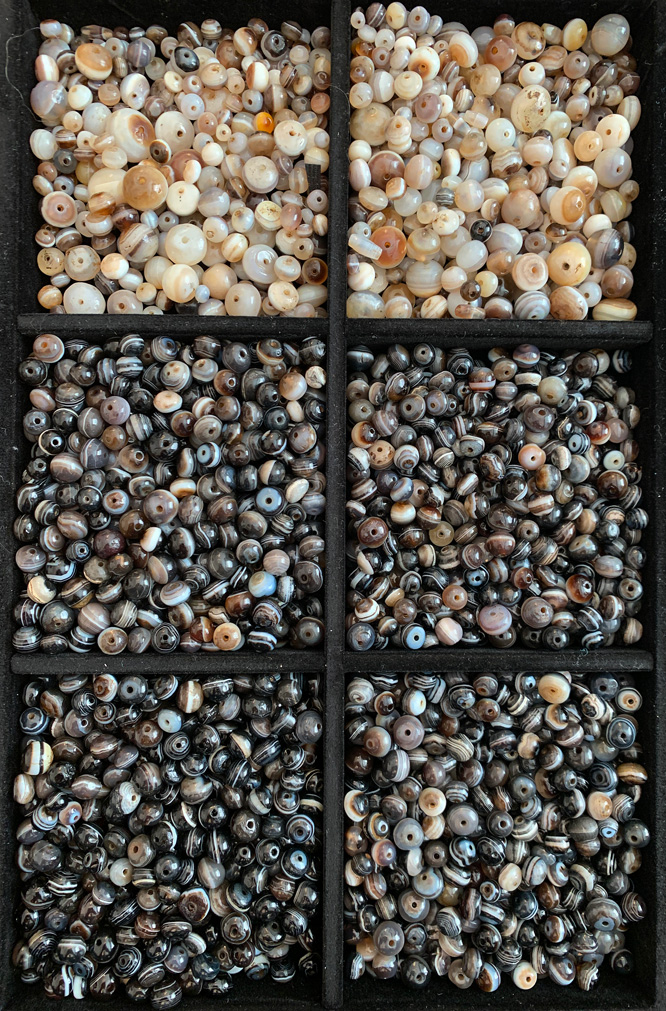
Click
on the
box
|
|
|
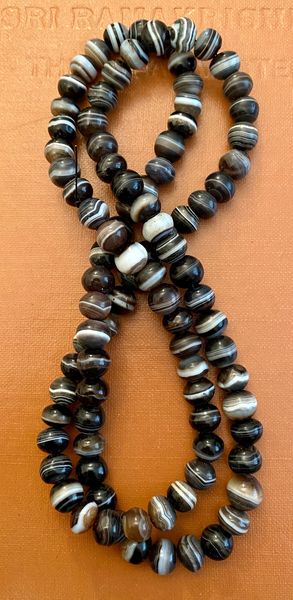
SM 1a -
average size 9mm -
'cooked'
Click on picture for a larger resolution
|
BEADS AS
CURRENCY
There's an intriguing saying in the
Konyak tribe: One bead necklace is equivalent to one
Nepali slave. This may seem strange to us today, but it
provides valuable insight into the role of beads in older
cultures.
Cultural customs and behavioral patterns within tribal societies
can often offer a unique window into our ancient past.
In the context of the Indus civilization, however, beads were
likely symbols of social status within an emerging labor and
class-based society, rather than units of currency. The idea of
using beads as money might seem natural today, but this concept
likely didn't exist in the early stages of history.
It's probable that only after the decline of the Indus
civilization did beads begin to evolve into a form of monetary
exchange. As trade expanded and societies grew more complex,
these small, portable, and universally valued items could have
found a new role in the economic systems of the time.
|
|
|
|
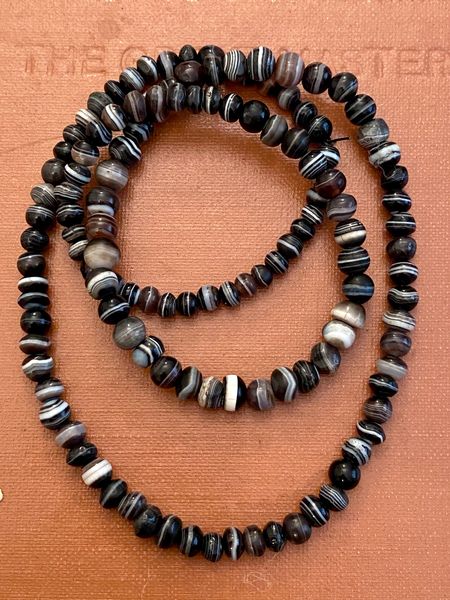
SM 1b - 5 to 6,5 mm - 'cooked'
Click on picture for a larger resolution
|
ATTRACTIVE, PORTABLE, AND RARE
The earliest forms of money needed to meet three essential
criteria: they had to be aesthetically pleasing, portable, and
difficult to procure or manufacture. This set of requirements
naturally led to items such as
shells
and beads being used as
mediums of exchange in increasingly organized and large-scale
trade systems. Hence, beads evolved from primarily being status
symbols to also serving the function of 'cash' in the burgeoning
urban trade economies of the Indo-Gangetic Plain during the
post-Indus period.
Beads, consequently, transitioned into Niksha, or circulating
money, akin to the later usage of
trade beads
in
Africa.
Interestingly, bead-currency was likely utilized within economic
systems even after the advent of the first
punch
marked coins
around the 6th century B.C. In a twist of historical irony,
history repeats itself: today, Sulemani and DZI beads are used
in facilitating transactions within China's parallel black and
gray economies.
|
|
|
|
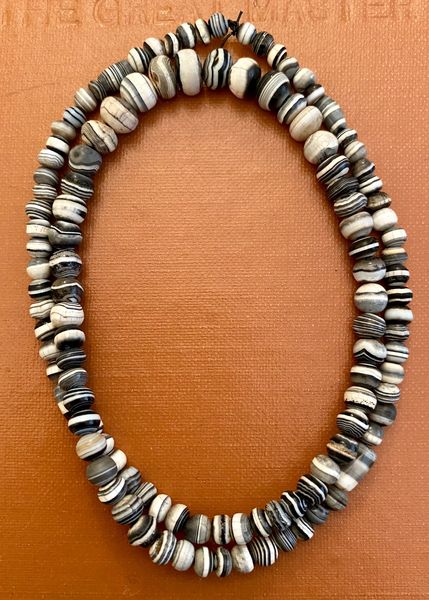
SM 1c -
4 to 8 mm - 'over cooked'
Click on picture for a larger resolution
|
THE UNIFORMITY OF MONEY BEADS
The reason for discussing the concept of beads as money
in the context of Indus beads, despite them not being used as
such, is to draw attention to a significant transformation in
the role and characteristics of beads:
When beads transitioned into serving as a medium of exchange or
money, they lost their distinctiveness.
In other words, as beads began to be standardized for their new
economic role, their individual artistic expressions and unique
features became less important, if not undesirable. The emphasis
shifted from the artistic and cultural value of each bead to its
uniformity and reproducibility, crucial attributes for any form
of currency. This metamorphosis marked a stark departure from
the array of shapes, colors, and materials that defined the
Indus beads and their individualistic appeal.
|
|
|
|
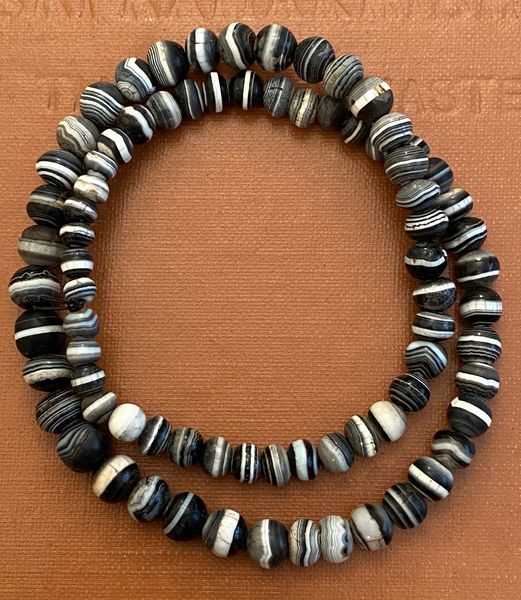
SM 1d -
5 to 8 mm - 'over cooked'
Click on picture for a larger resolution
|
THE EVOLUTION TOWARDS UNIFORMITY
A critical requirement for a bead to evolve into a currency was
its ability to be recognized and valued over larger geographical
areas, necessitating a certain level of standardization. The
bead had to morph from a symbol of unique artistic expression
and rarity into an item of reproducible and recognizable
uniformity, akin to shells.
As these new requirements took precedence, the emphasis on
beauty, rarity, and diversity inherent in bead production had to
be down-prioritized. The aesthetics and individuality that
characterized the Indus beads gave way to an emphasis on
replicability and standardization.
This shift likely serves as the primary explanation for the
striking transition from the extraordinary variety and
uniqueness of beads seen in the Indus period to the relatively
uniform, mass-produced beads that emerged later. This
transformation marked a significant turning point in the role of
beads in society, from a symbol of personal status and cultural
expression to a utilitarian tool for economic transactions.
|
|
|
|
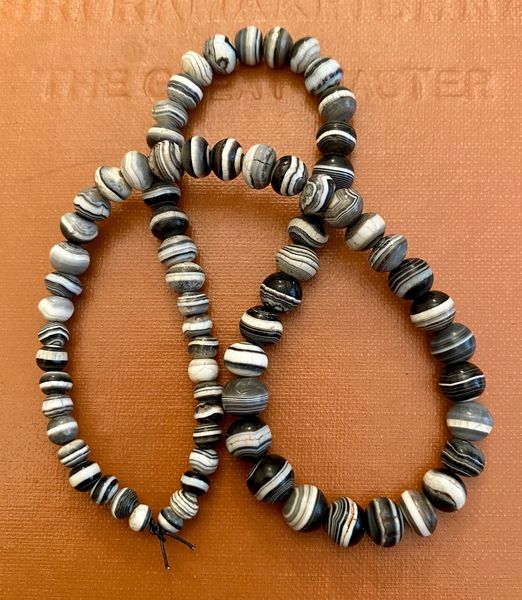
SM 1e
- 4 to 7,5 mm - 'over cooked'
Click on picture for a larger resolution
|
The prolific presence of beads, particularly from around 700
B.C. and the subsequent 1000 years, can be attributed to their
adoption as a form of currency. Despite the estimated 90% of
'ancient' beads in today's market being inauthentic, the
remaining 10% constitute a staggering number, hinting at the
scale of bead production in ancient times. In fact,
archaeological excavations occasionally unearth massive
quantities of ancient beads in a single find, sometimes
amounting to as much as 50 kg. This is analogous to the mass
production of automobiles by Ford in the 1930s, where the demand
for a ubiquitous commodity led to a substantial increase in
standardized, look-alike products.
|
|
|
|
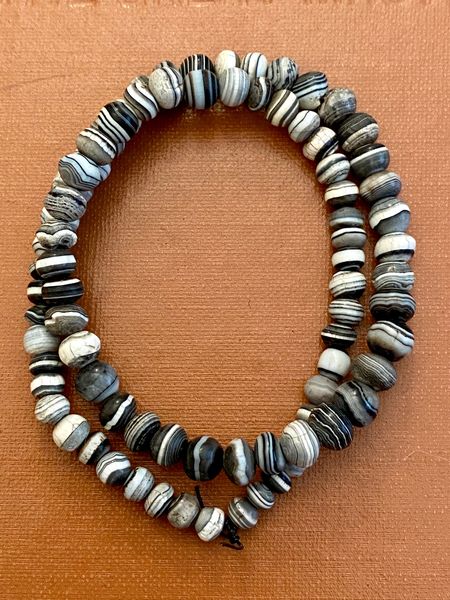
SM 1f
- 5 to 7 mm - 'over cooked'
Click on picture for a larger resolution
|
|
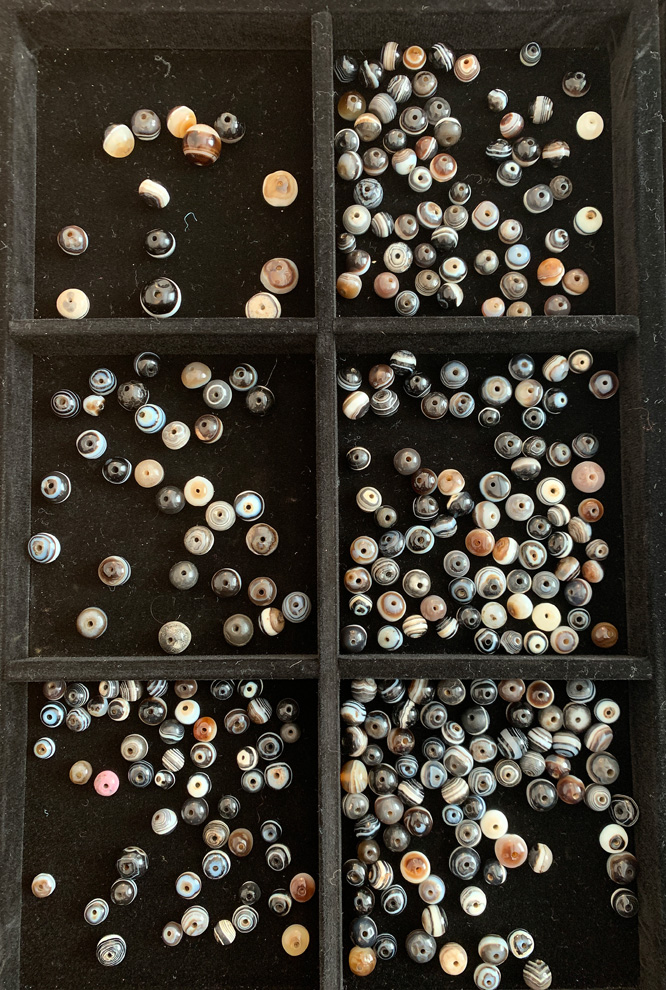
Click on
the box
|
|
|
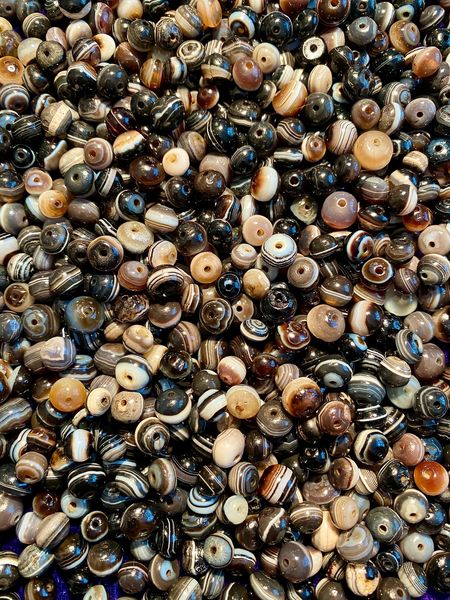
SM 2a
Click on picture for a larger resolution
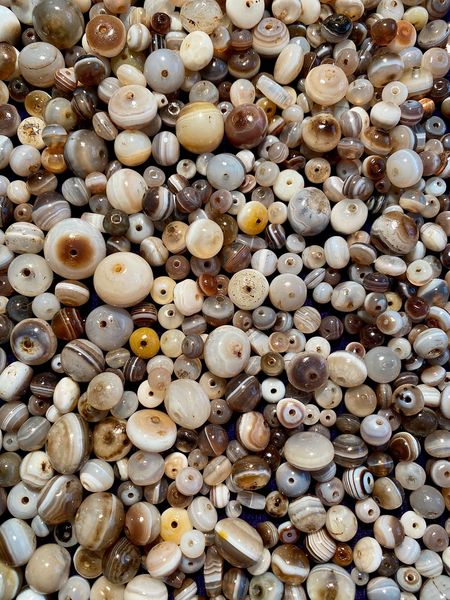
SM 2a
Click on picture for a larger resolution
|
SULEMANI AGATE
Displayed in illustration 1, 2, 3 & 4 you can observe
variations of typical Sulemani
agate beads.
Note the blank shining surface of these
beads.
Cylinder shaped Sulemani
Onyx
beads
Onyx is virtually black agate
which is two-layered. In the case of sulemani beads the
layers are primarily consisting of black/brownish and
white.
|
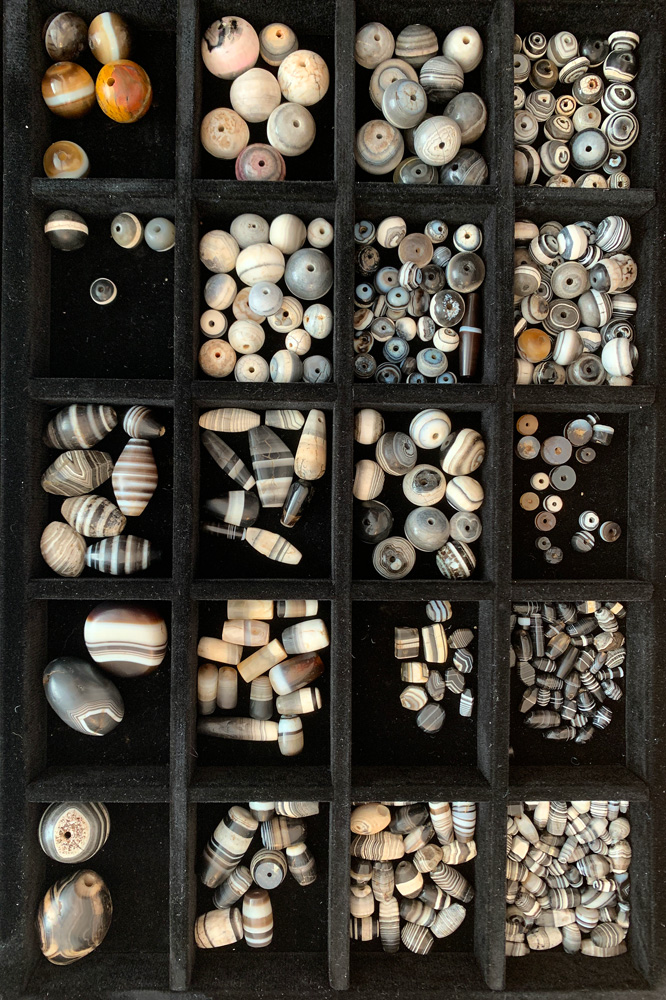 |
|
|
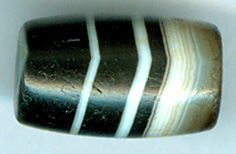
SM 3 - 17 * 11 mm |
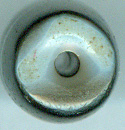 |
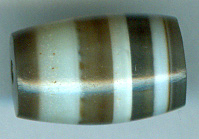
SM 4 - 14 * 9 mm
|
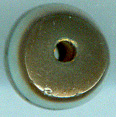 |
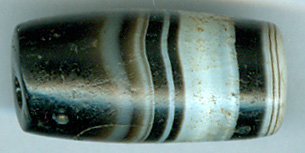 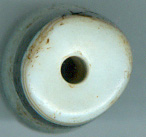
SM 5 - 23 * 10 mm
Illustration 3
|
|
Truncated Convex Bicone Sulemani Onyx
Beads
|
|
|
|
Illustration 4
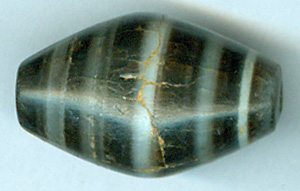 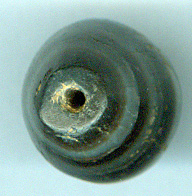
SM 6 -
22 * 14 mm
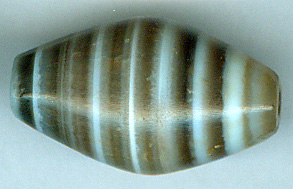 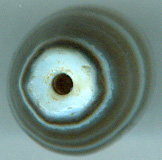
SM 7 - 23 * 13 mm
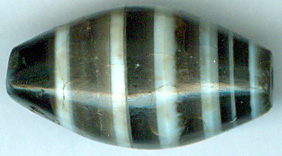 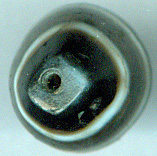
SM 8 - 23 * 12 mm
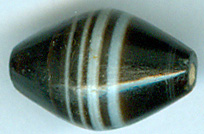
SM 9 - 15 * 10 mm
Pendant sulemani
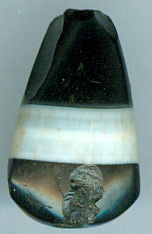
SM 10 - 18 * 11 mm |
AGATE HEATED BY FIRE
Displayed in the illustrations 5,6 & 7 you will see a
different kind of black and white banded agate than the
beads shown above. The patina of these two kinds of
agate is quite different.
|
|
|
|
|
The difference in
patina
In illustration 5 the beads do not display the same kind
of glass-like shine as the beads in illustration 1, 2, 3
& 4. They have a more dusty, not reflective surface.
Greater contrast lines
Another characteristic is that the beads displayed in
illustration 5 show greater contrast between the black,
gray and white colors.
Black lines in white stone - not white lines in black
stone
Often the presence of white colored stone is, as you can
observe in illustration 6 dominating in this type of
agate:
|
|
|
|
Illustration 6
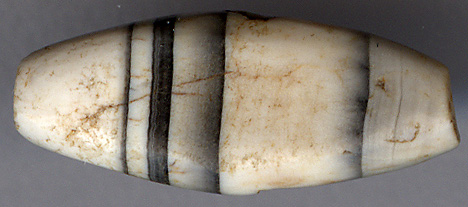
SM 22 - 19 * 7,5 * 4 mm |
One could as a general rule say that the typical
Sulemani beads as displayed in illustration 1, 2,
3 &
4 have
stripes of
white
in a black
stone where this other kind of
beads displayed in illustration 4 & 5
have black stripes
in
white
agate.
50 shades of gray
It is also worth to note that this type of agate stone
often displays distinct bands of gray
color
in many shades:
|
|
|
Illustration 7

SM 23 - 22 * 6 * 5 mm
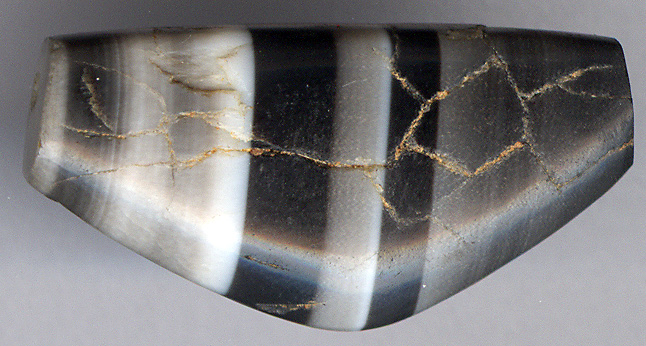
SM 24 - 25,5 * 18 * 5 mm
A wonderful bow bead. Note the
distinct
black, gray and white color bands.
These beads were sourced from Burma.
They learned together with the spread of
Buddhism to manufacture these beads. |
The
absence of brown colors
Furthermore, this agate does not display brown or
brownish colors as you will often observe in the more
common Sulemani agate beads. An example of this brownish
color can be observed in these typical
Sulemani/babagoria beads:
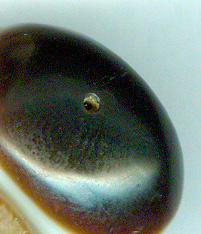
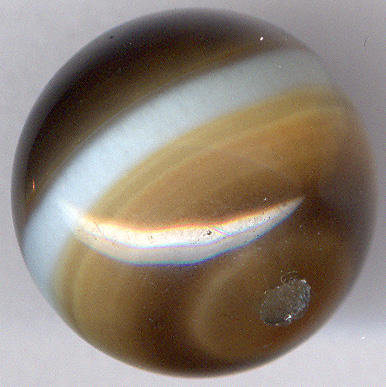
CHANGE THROUGH
HEAT TREATMENT
The difference between the
'normal' Sulemani beads and these more white, gray and
black beads is due to differences in the heat treatment
process. These beads have been either deliberately or by
accident been put in fire making them more
white-black-grayish. The change might also be caused by
the heat from a funeral pyre.
Great art through fire!
Whatever the reason... seen from an artistic viewpoint I
love the appearance of these beads much more than the
more ordinary ones with their brownish colors as you can
observe above.
That leads me to the last theory, a theory I believe is
closest to the truth: These beads have been deliberately
produced to look like they do. They are simply too
beautiful to be a coincidental side product of a burial
pyre. According to Mr. Malik Hakila, a world leading
bead expert and a bead shop owner from Kathmandu who
also runs a bead factory in Cambay, Gujarat, there were
two separate ancient bead cooking techniques involving
in producing these Central Indian beads.
1) Ancient dry cooking by high temperature
The oldest technique, as one can observe in
illustration 5 to 8, was to heat-treat the beads
without oil, like the ancient Indians did with
carnelian, but with a much higher temperature. In this
way, the beads became non-translucent and with intense
jet black and powerful white bandings, which is an
advantage seen from an artistic viewpoint. The problem
with this technique is that it weakens the stone so
badly that it easily breaks. Even in the finished
specimen, one can find a lot of scars and cracks, as you
can observe in illustration 7. Scars and cracks
can happen anytime with this type of beads. I even had
some specimen that cracked right in my hand.
|
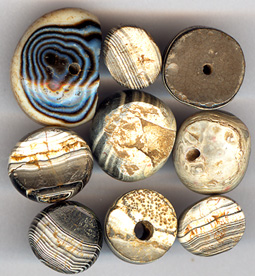
Click on picture for larger version
|
Vulnerable beads
In central India, there are ancient sites with
huge piles, almost ton's of ancient broken beads
made with the old and dry heating method. The
massive presence of this type of beads in a
broken condition indicates the problem with the
fragility of beads made by the old production
method.
A lot of these beads simply did not survive the
manufacturing process itself.
On the illustration, you can observe beads taken
from such a junk pile close to the bead
manufacturing place. Here we can observe beads,
broken before and after getting polished and
some broken during the tumbling process itself
as with the bead in the upper right corner with
a polished bead crack surface.
|
2) A more modern oil cooking
technique
The other and more modern, but still ancient technique
would be to cook the beads in oil. This technique keeps
the natural transparent parts of the agate and at the
same time upholds the strength of the bead. This method
replaced the former one about 2300 years ago. However,
the two techniques have most probably run parallel for
quite some time, depending on customer demand.
Larger & older holes in the dry & hot cooked beads
The holes are as you can observe in illustration 5 to
8 and mostly much larger in the dry & hot cooked
beads than in the more common agate bead in this
traditional oil cooked bead:

The generally larger holes in the dry & hot cooked beads
support the theory of two distinctly different ways of
bead treatment with radical different appearances.
Larger variation in motives in dry & hot cooked beads
Displayed in Illustration 8 one can observe the
presence of ultra swirling and abrupt geometric motives
and multiple eye formations in the dry cooked and
super-heated older type of beads. Swirling circular
motives are typical for normal agate, but even more so
in these specimens. It seems the different layers in the
agate chosen for dry & hot treatment are more irregular
and hence more interesting. Therefore my next hypothesis
is: In order to get the best art beads out of the
swirling effects of the agate, the the beads with most
interesting patterns and swirls were chosen for the old
heat treatment technique and the one with more regular
banding were chosen for the new technique.
The most wonderful artful swirling play of circles is
displayed in illustration 8
below, but can also clearly be observed in
illustration 5.
|
|
|
|
|
THE
USE OF OIL COOKED BEADS AS CURRENCY
For every over-cooked more ancient bead there are
hundreds of oil cooked beads.
Is it a coincidence that oil cooked beads
in mass production appeared on the historic Indian scene
at the same time as the rise of the use of money,
nishka? I don't think so. The oil-cooked beads
fulfilled the need of currency before the minted coins
took hold. For a long time, bead-coins and metal coins
most probably have coexisted. In this process of
monetization of beads, the production of the over-cooked
beads had to make way for the oil-cooked one out of two
simple reasons.
Oil-cooked beads were more durable and were not likely
to break when shifting hands in circulation.
Oil-cooked beads were less individual and artistic. When
cooked in oil the beads tend more to look like each
other, which is an advantage when used as currency.
With the rise of urban trade, artistic beads had to give
way to the more consistent mass production of
bead-currency.
THE TALISMANIC POWER OF THE ANCIENT DRY & HOT COOKED
BEADS
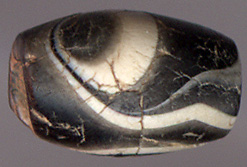
In a way, all ancient
beads are amulets - if one think they are. The
'amuletic' power of a bead can never be isolated from
the particular belief system in which the owner of the
bead orients himself. In my view the world is
constructed out of collective minds accepting the same
story told reality. The naming of beads is part of the
same game. Should we call these beads Sulemani,
Bhaisayaguru or Babagoria beads? Each name attracts a
certain collective reality, and these 'realities' will
fight internally about who is the most real reality.
Beauty is my religion
My belief system is centered around beauty
- not beautiful beauty, not a perfect beauty, but
transcendent beauty hidden in the perfection of the
imperfect. I would call it the sublime.
Imperfect, fragile bead amulets like these ancient over
cooked beads are full of story telling like faces of old
men and women. Therefore I call these beads sublime, and
that is why I wrote a
praise to the scarred bead.
To see the world as a story told reality or maybe even
fantasy is in fact very close to the ancient Indian
philosophy and according to my observations exactly the
part of Indian religious culture that originated, not
from the Arian invasion, but from India's own ancient
super culture: the Indus culture.
Where we in the West tend to describe all mind made
realities as unreal in opposition to
positivistic science, the ancient Indian thinking is one
step ahead in pointing out - long time before the
quantum physicists - that the observer is actually
creating the observed.
Therefore beads have the power you observe them with.
But why ancient beads? Why not something plastic
fantastic?
Exoplanetarian beauties
When I look at these worn and torn ancient dry &hot
cooked beads - sometimes looking like exoplanets from
far away solar systems - I am taken by awe. They are the
eye bead displayed above full of fragile cracks emitting
ancient light. Their swirling unpredictability makes
them perfect as amulets setting the course for my own
unknown future.
The typical Asian collectors would not like them due to
their imperfections.
I however, observe this imperfection as perfectly
imperfect.
An ancient bead is due to its history and aesthetic
appearance an ideal focus point for meditative
concentration of the powers of and in the mind. The
scars, marks, and cracks are ancient signatures of time
itself.
It is an ideal hub where the Soul and the zero can meet,
but not in the ideal formlessness of the zero alone.
Because by accepting the scar as beautiful, you accept
the imperfect life you live as beautiful. No need of
escaping into the perfect, but depersonalized space of
the zero.
THE (W)HOLE IN THE EYE
- THE ZERO AND THE SOUL
The wonderful ancient big holed ball
beads displayed here illustrates the ancient bead makers
preference to put the hole as far as possible in the
center of the eye.
The reasons for placing the hole in the eye could
be
several. One is most probably religious and symbolic.
The other could be purely out of
aesthetic reasons.
It is worth noting that the hole in a bead also
resembles a zero. This is particularly interesting
because it was the Indians who invented the zero. The
Hindi name for zero is still today the word shoonyo,
an old Buddhist word for the fundamental perfect
emptiness of existence.
|
|
|
|
Illustration 9 |
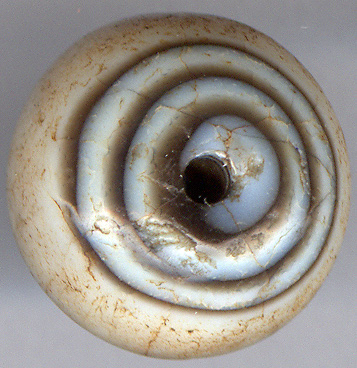
SM 32 - 14,5 * 11
|
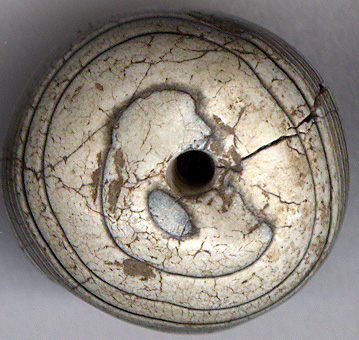
SM 33 -
15 * 12 mm (Afghanistan)
- Sold |
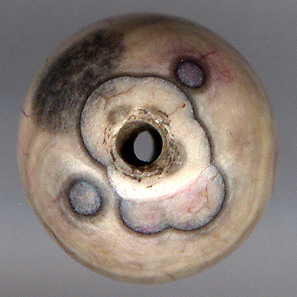
SM 34 - 11,5 * 10 mm
|
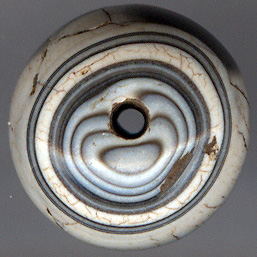
SM 35 - 10 * 8,5 mm |
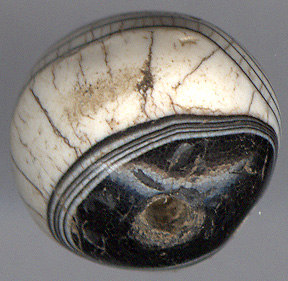
SM 36 - 11,5 * 11 mm |
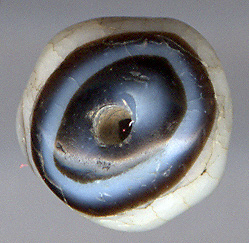
SM 37 - 9 * 7 mm |
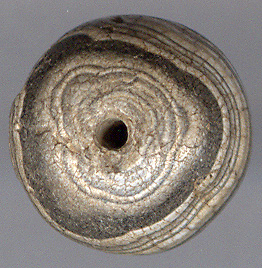
SM 38 -
10 *
9,5 mm -Sold |
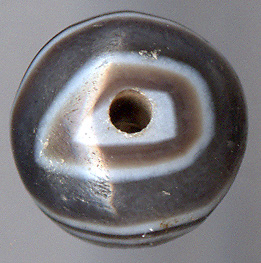
SM 39 - 10 * 8,5 mm |
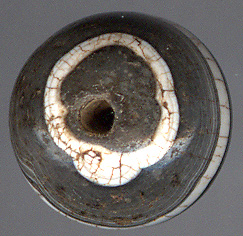
SM 40 - 9 * 7,5 mm |
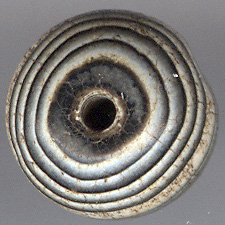
SM 41 - 9 * 7,5 mm -Sold |
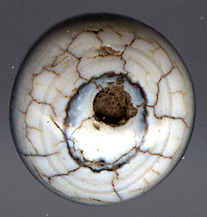
SM 42 - 8 * 6,5 mm |
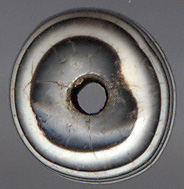
SM 43 - 7,5 * 6,5 mm -Sold
|
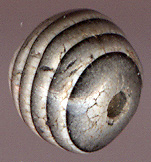
SM 44 - 6 * 5 mm -Sold
|
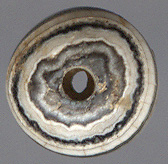
SM 45 - 6,5 * 5,5 mm |
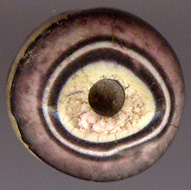
SM 46 - 7,5 * 5,5 mm -Sold
|
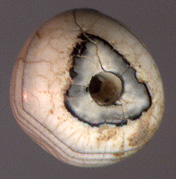
SM 47 - 6 * 5 mm
|
|
|
Below you can observe a few beads with holes drilled
with apparently no considerations to the eye patterns.
The reasons for this could be several. Mainly I think it
is due to technicalities, in the sense that the very
nature of the stone could demand the hole to be drilled
in a
particular
place.
The hole could also be put
as you can observe in the beads below out of other
aesthetic motivations. The reason could also be due to a
bead makers ignorance or not caring about symbolic eyes.
There were countless centers for bead making in India -
both seen in a historical and geographical view.
Most probably these centers had different cultural
and religious views. As there always in ancient India
were many different gods and religions there must also
have been a lot of difference in the context of
mindsets.
So it is possible that we had centers of bead making
where the bead makers did not care about symbolic eyes
and holes. It is here worth to remember that India had a
great time of skepticism and atheism already 100 years
before the birth of the Buddha.
|
|
|
|
|
NEW HOLES IN OLD BEADSThis ancient bead
displayed below has no hole.
It never made it the whole way to the end of the manufacturing
process. It is not uncommon to find such
beads.
The wonderful beads SM 53,54 and 55
just below are ancient. However,
they were found without hole. So the finders of the beads
drilled new holes in them. Unfortunately,
my scanner is somehow not able to catch the true translucent
beauty of these beads.
|
|
|
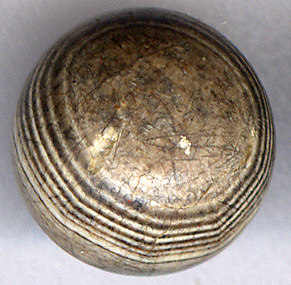
SM 53 - 11 mm - a bead whithout hole

SM 54 - 15 mm
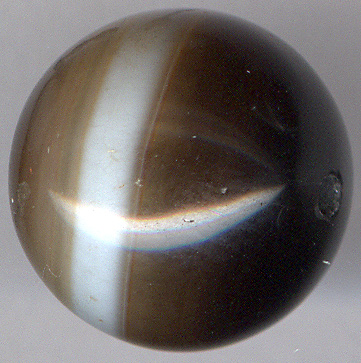
SM 55 - 14 mm
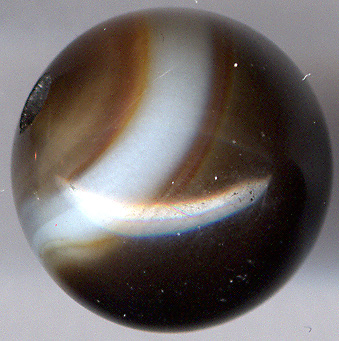
SM 56 - 13,5 mm
|
BABAGORIA
BEADS IN VARIOUS DESIGNS
In the following section you can, if you
like, try to see the difference between the two kinds of
agate.
Since I
hunt the
older dry & hot cooked
agate
beads, most of the beads
displayed below
belong to that category.
|
|
|
|
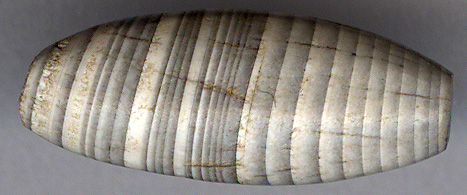
SM 57 - 18 * 7 * 6 mm
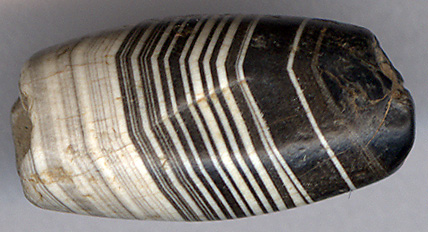
SM 58 - 17 * 8,5 * 7 mm
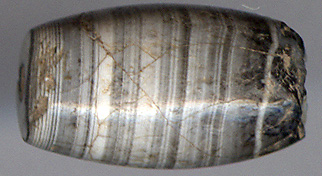
SM 59 -
12 * 7
mm
|
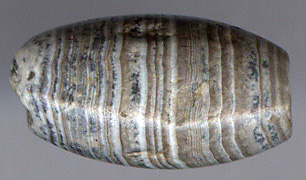
SM 60 -
12 *
6,5 mm
|
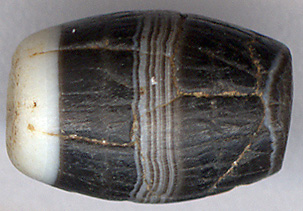
SM 61 - 12 * 8 mm |
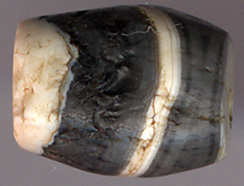
SM 62 - 9 * 7 * 6 mm
|
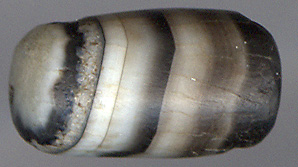
SM 63 - 11 * 6,5 mm |
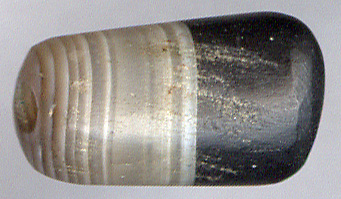
SM 64 - 12,5 * 7 mm |
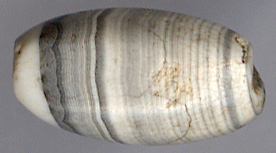
SM 65 -
|
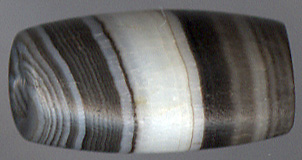
SM 66 - 11,5 * 6 mm
|
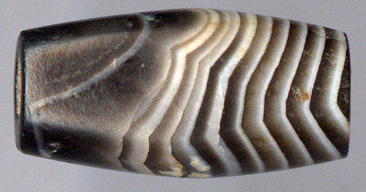
SM 67 - 14 * 7 mm
|
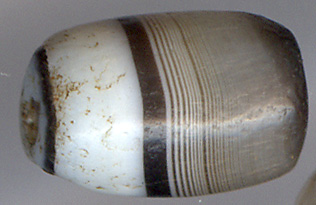
SM 68 - 12 * 7,5 mm
|
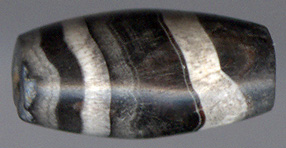
SM 69 -
10,5 * 5 mm
|
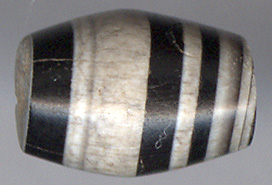
SM 70 - 9,5 * 7 mm
|
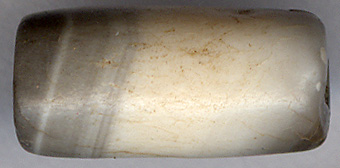
SM 71 - 13 * 6 mm
|
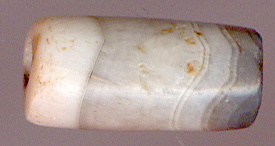
SM 72 - 9 * 5 mm |
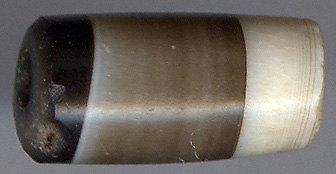
SM 73 - 12 * 6 mm
|
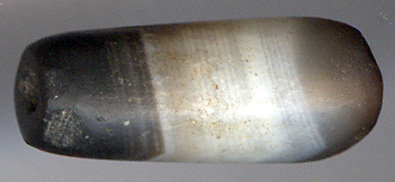
SM 74 - 15 * 6 mm |
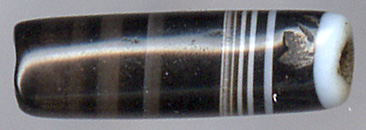
SM 75 - 14 * 4 mm
|
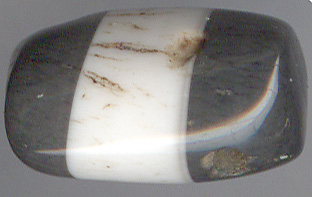
SM 76 - 12,5 * 7 mm |
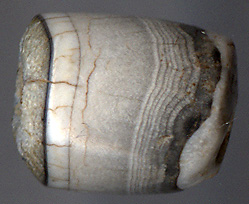
SM 77 - 9 * 7,5 mm
|
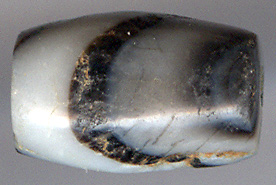
SM 78 - 10 * 7 mm |
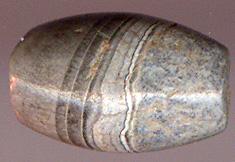
SM 79 - 9 * 5 mm
|
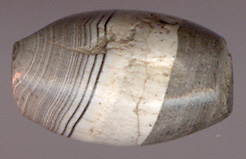
SM 80 - 9 * 5,5 mm |
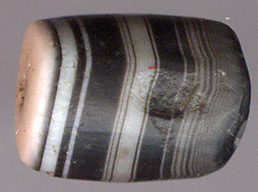
SM 81 - 9 * 7 mm |
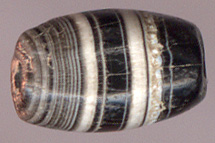
SM 82 - 8 * 6 mm |
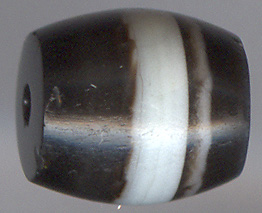
SM 83 - 9 * 8 mm |
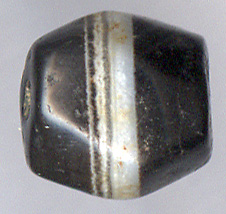
SM 84 - 8 * 7 mm
|
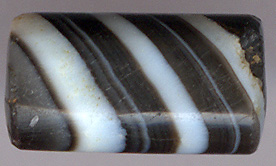
SM 85 - 11 * 6 * 4 mm |
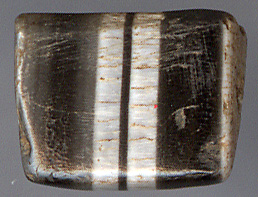
SM 86 - 9 * 7 * 4,5 mm
|
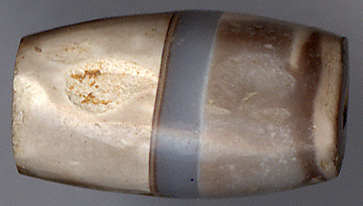
SM 87 - 14 * 8 mm
Note the very rare blues stripe |
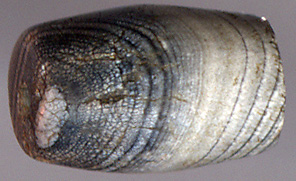
SM 88 -
11 * 7 mm
|
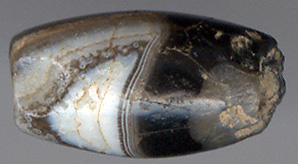
SM 89 - 12 * 5,5 mm |
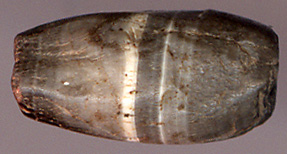
SM 90 -
11 * 5 mm
|
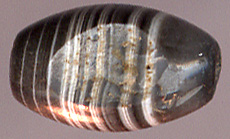
SM 91 - 9 * 5 mm |
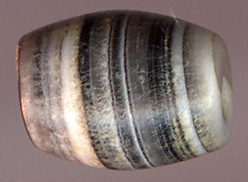
SM 92 -
9 * 6 mm
|
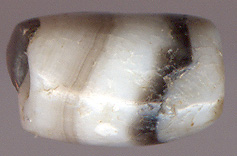
SM 93 -
8,5 * 5,5 mm
|
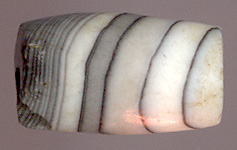
SM 94 - 8,5 * 5 * 4 mm |
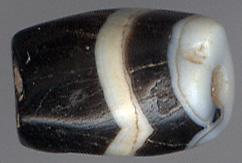
SM 95 - 9 * 6 mm
|
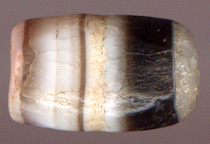
SM 96 -
8 * 5 mm
|
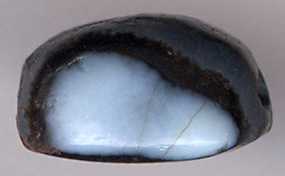
SM 97 - 11 * 8,5 * 6 mm |
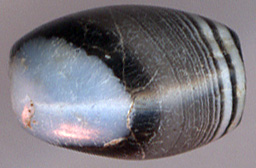
SM 98 - 10 * 6,5 mm
|
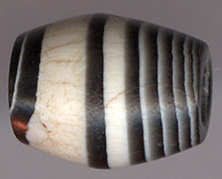
SM 99 - 8 * 6,5 mm |
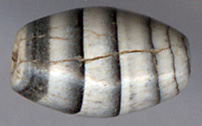
SM 100 - |
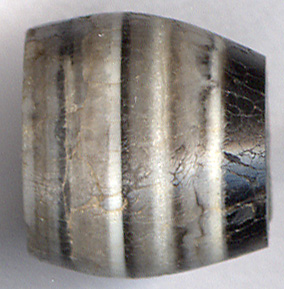
SM 101 - 10 * 11 mm
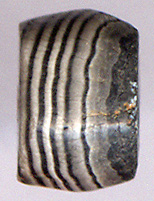
SM 102 - 5 * 8 mm |

SM 103 - 5 * 6 *
5,5 mm
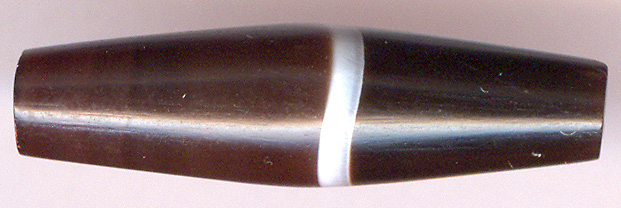
SM 104 -
25 * 7 mm
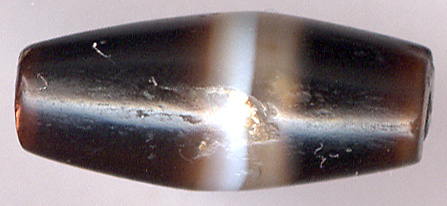
SM 105 - 17,5 * 7 mm
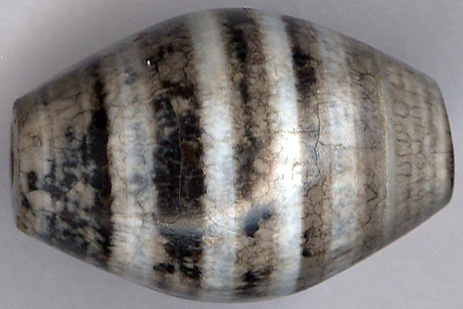
SM 106 -
18,5 * 12 mm
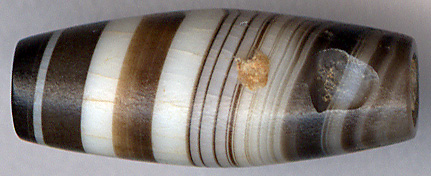
SM 107 -
17 * 6,5 mm
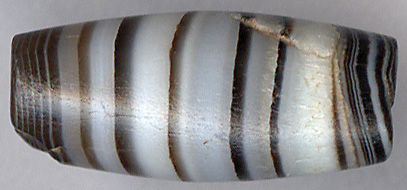
SM 108 - 16 * 7 mm
|
BALL BEADS
|
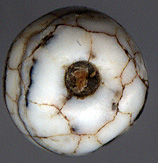
SM 109 - 6 * 5 mm |
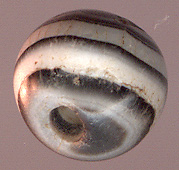
SM 110 - 6 * 6,5 mm |
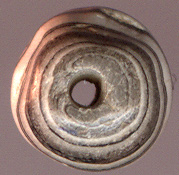
SM 111 - 7 * 6 mm |
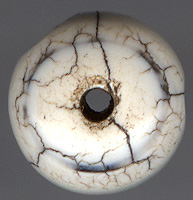
SM 112 - 7,5 * 6,5 mm |
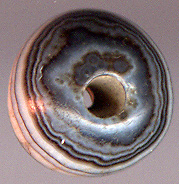
SM 113 - 7 * 6,5 mm |
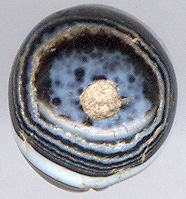
SM 114 - 7 mm |
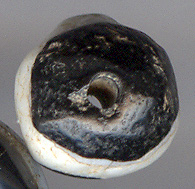
SM 115 - 7 * 6 mm |
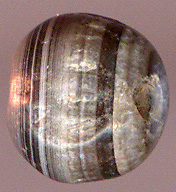
SM 116 - 7 * 6 mm |
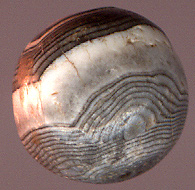
SM 117 - 7 mm |
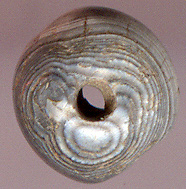
SM 118 - 7 * 5 mm |
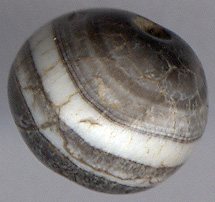
SM 119 - 8 mm |
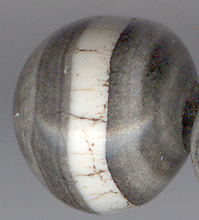
SM 120 - 8 mm -Sold |
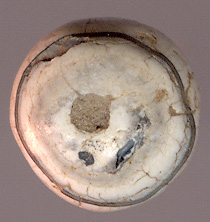
SM 121 - 8 * 7 mm |
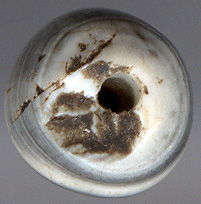
SM 122 - 8 mm |
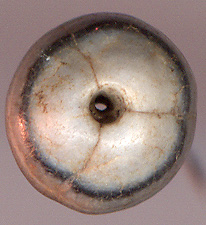
SM 123 - 8 * 7 mm |
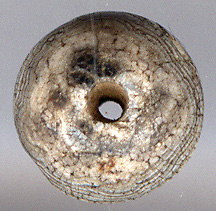
SM 124 - 8 * 7 mm |
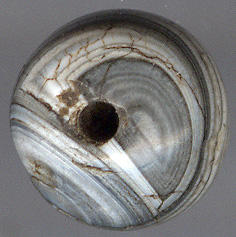
SM 125 - 9 * 7,5 mm |
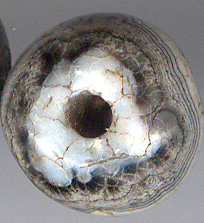
SM 126 - 9 * 6,5 mm |
| |
|
|
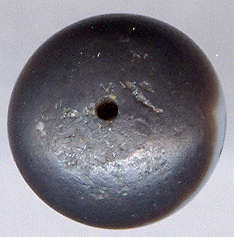
SM 127 - 9 * 7 mm -Sold
|
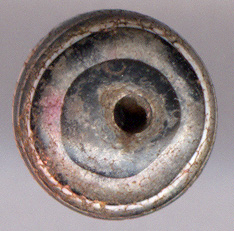
SM 128 - 9 * 6,5 mm
|

SM 129 - 9,5, * 8,5 mm
|
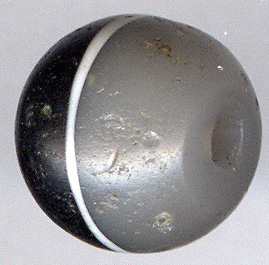
SM 130 - 9 * 10 mm
|
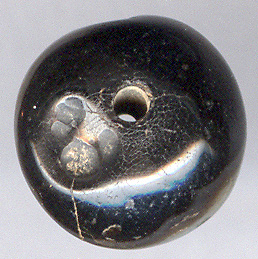
SM 131 - 10 * 7 mm -Sold
|
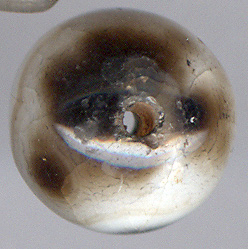
SM 132 - 10 * 9,5 mm |
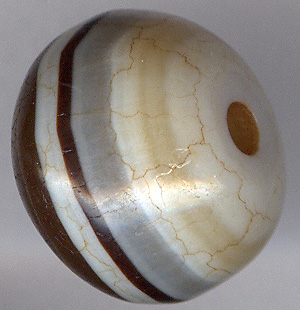
SM 133 - 10 * 12 mm -Sold
|
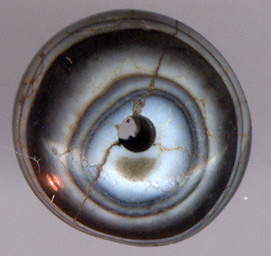
SM 134 - 10 * 6,5 mm -Sold
|
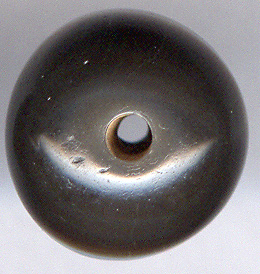
SM 135 - 10 * 10,5 mm
|
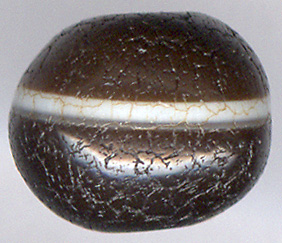
SM 136(1) - 11 * 9 mm -Sold |
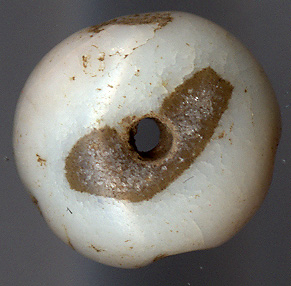
SM 137 - 11,5, * 7,5 mm
|
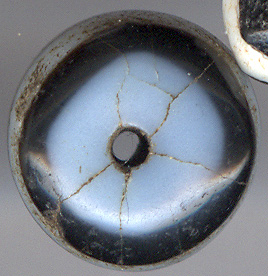
SM 138 - 11 * 7 mm |
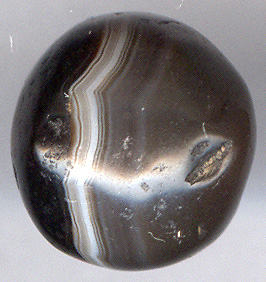
SM 139 -
11 * 10,5 mm
|
| |
|
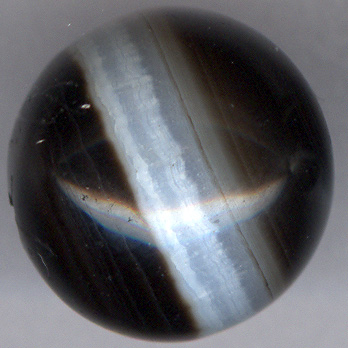
SM 140 -
14 mm
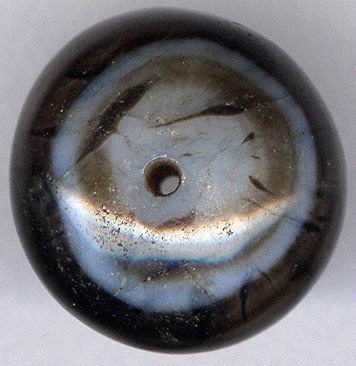
SM 141 -
14 * 12 mm
Ancient bead with a new hole
|
This wonderful flat oval tabular, natural banded
Sulemani agate bead displayed blow has a beautiful
patina and a unique pattern. This bead has been
heat treated with honey or sugar.
|
|
|
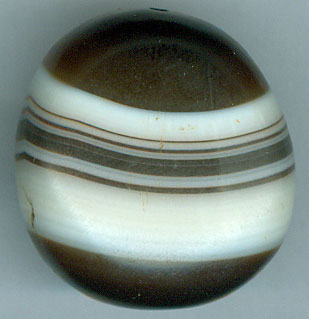 
SM 185 -
26 * 23 * 12 mm
Origin: The Himalayas
Period: 300 B.C. to 1000 A.D.
|
|
|
|
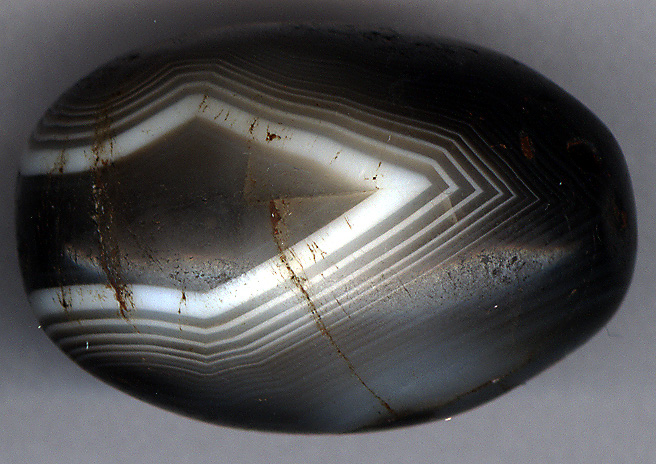
SM 186 -
27 * 18 mm
|
Sulemani pendant beads
|
|
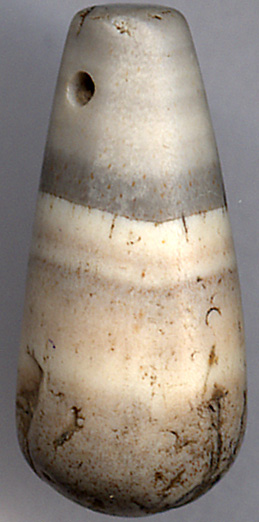
SM 187 -
22 * 9,5 mm
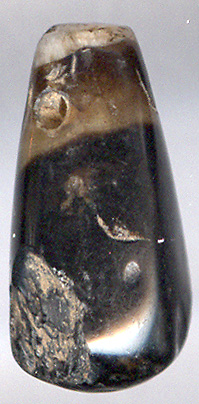
SM 188 -
15 * 8 mm

SM 189 -
21 * 9 * 7 mm
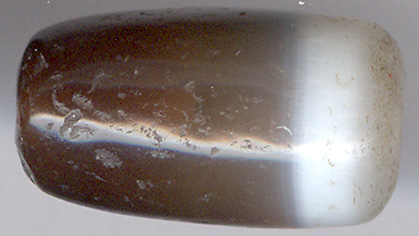
SM 190 -
11,5 * 9 mm
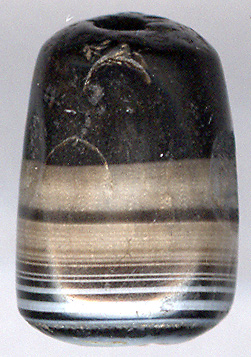
SM 191 -
14 * 9 mm
|
Buddhist Bhaisajyaguru beads
Sulemani agate was as mentioned in the beginning used by Sufi
Moslem Faqirs and before that, they were used as Buddhist prayer
beads. Especially Afghanistan is interesting in this context.
Afghanistan was a predominantly Buddhist culture up to 1000 AD!
The ball shaped Sulemani beads are
also known as Bhaisajyaguru beads.
These Prayer beads remove according to the Tibetan tradition,
roots of diseases, ensures health and longevity.
In
Mahayana Buddhism,
Bhaisajyaguru represents the
healing aspect of the historical Buddha Sakyamuni. These beads
have been in the hands of beings with pure intentions for
generations. Some of these beings may even have been
enlightened!
|
|
Here you can see the wonderful Bhaisajyaguru eye bead from
Afghanistan that is displayed on the top of the page
Bead Magic. It really shows that
the bead hole itself actually can serve as a Magic Eye!
|
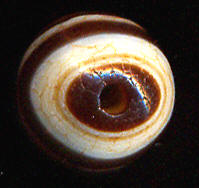
SM 0 - 14 * 14 mm
|
And here
are some boxes to buy from:
Note the peculiar bluish light in these rare specimens
SULEMANIBOX 1

Click on boxes for larger picture
SULEMANIBOX 2

SULEMANIBOX 3

SULEMANIBOX 4
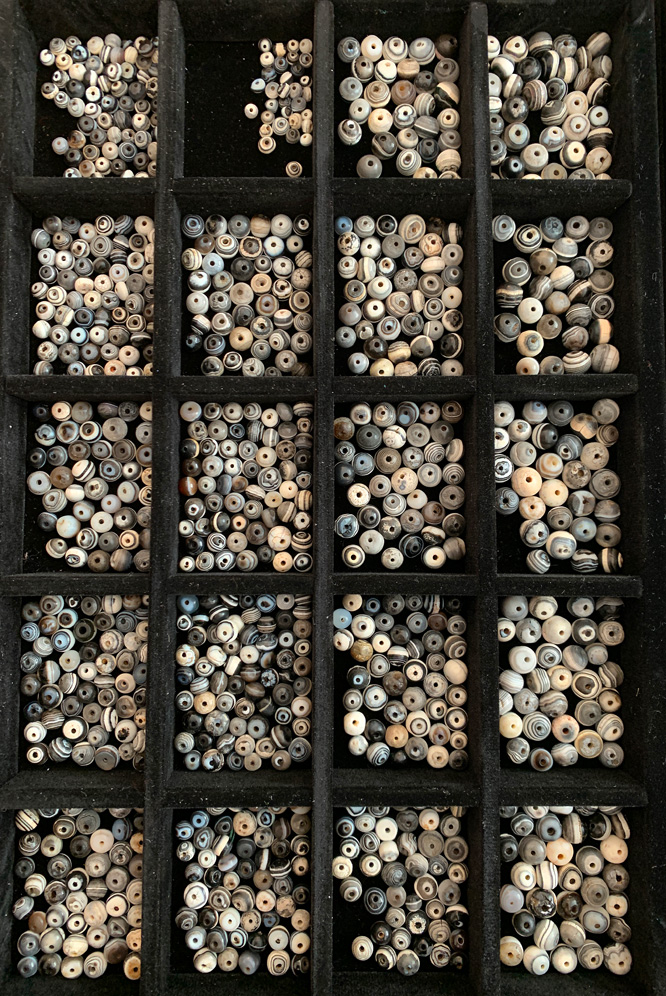
SULEMANIBOX 5
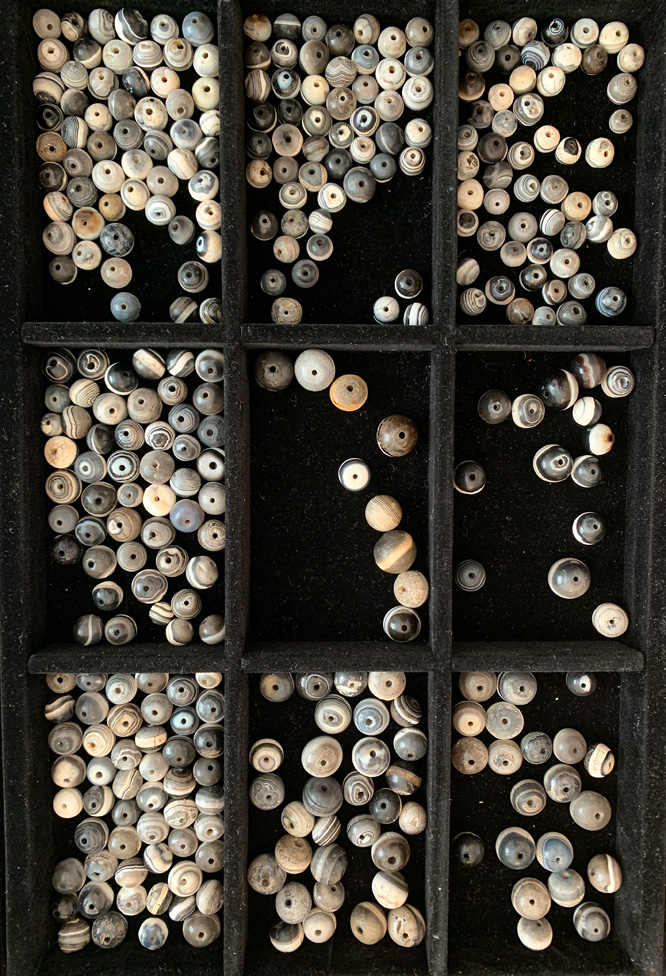
|